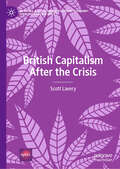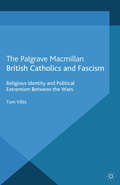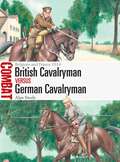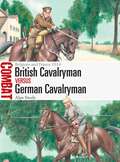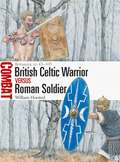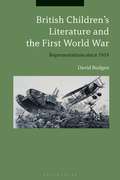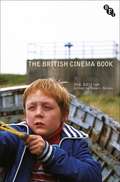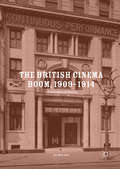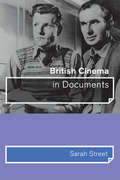- Table View
- List View
British Capitalism After the Crisis (Building a Sustainable Political Economy: SPERI Research & Policy)
by Scott LaveryThe 2008 financial crisis rocked British capitalism to its foundations. More than a decade after the crash, the country is still dealing with its consequences. This book explores the extent to which British capitalism has been reconfigured in this tumultuous period. Advancing an in-depth analysis of the political economy of New Labour, the Coalition and the period after Brexit, the book argues that deep structural weaknesses have been re-embedded within British capitalism. The Coalition promised to eliminate the deficit in one parliament and to ‘rebalance’ the British economy. It did neither. Instead, real wages slumped, uneven development intensified and productivity stagnated. An era of volatile post-crisis politics - exemplified by Brexit, the May government and the rise of Corbyn - emerged in this context, threatening the foundations of the old order. This book is required reading for students and scholars interested in the fractious political economy of British capitalism after the crisis.“Lavery’s book on the flawed political economy of Britain’s hybrid variant of capitalism after the 2008 financial crisis is a tour de force. It is theoretically sophisticated, historically informed, conjuncturally nuanced, empirically robust and provides a solid basis for analysing developments following the Brexit debacle, whatever these might be.”—Bob Jessop, Lancaster University, UK“If you are not yet familiar with Scott Lavery’s work, you very soon will be, as it is becoming increasingly difficult to overlook. With a clear mastery of both the politics and the economics of Coalition attempts to reduce the size of the state, Lavery shows with compelling precision how far and how quickly post-crisis Britain travelled from New Labour’s previous ‘one nation’ approach to macroeconomic governance.”—Professor Matthew Watson, University of Warwick, UK“British capitalism was changed but not reformed after the financial crisis, and its deep pathologies now find expression in political volatility and ideological polarisation. In a persuasive and rich analysis Scott Lavery shows how we got to this point and what the future might hold.”—Andrew Gamble, University of Sheffield, UK
British Catholics and Fascism: Religious Identity and Political Extremism Between the Wars
by T. VillisDrawing substantially on the thoughts and words of Catholic writers and cultural commentators, Villis sheds new light on religious identity and political extremism in early twentieth-century Britain. The book constitutes a comprehensive study of the way in which British Catholic communities reacted to fascism both at home and abroad.
British Cavalry Equipments 1800–1941: revised edition (Men-at-Arms)
by Mike ChappellThis revised edition of Mike Chappell's original Men-at-Arms 138 represents nearly 20 years' new research. It covers the saddlery, horse furniture, and personal equipment of the British horsed cavalryman from the early stages of the Napoleonic Wars until the final disappearance of the mounted arm during World War II. Such details are essential for an understanding of how cavalry fought in the 19th and early 20th centuries, since the design of equipment was intimately connected with cavalry tactics in any particular period. Students of campaign history, and particularly modellers, will find here a mass of specific information, illustrated with photographs, diagrams, drawings and full colour plates.
British Cavalry Equipments 1800–1941: revised edition (Men-at-Arms)
by Mike ChappellThis revised edition of Mike Chappell's original Men-at-Arms 138 represents nearly 20 years' new research. It covers the saddlery, horse furniture, and personal equipment of the British horsed cavalryman from the early stages of the Napoleonic Wars until the final disappearance of the mounted arm during World War II. Such details are essential for an understanding of how cavalry fought in the 19th and early 20th centuries, since the design of equipment was intimately connected with cavalry tactics in any particular period. Students of campaign history, and particularly modellers, will find here a mass of specific information, illustrated with photographs, diagrams, drawings and full colour plates.
British Cavalryman 1792–1815 (Warrior)
by Richard Hook Philip HaythornthwaiteIn the campaigns of the French Revolutionary and Napoleonic Wars, the deserved reputation of the British infantry has tended to overshadow the contribution of the cavalry, but in fact they did form an integral part of the army, carrying out duties crucial to the success of other arms. British Cavalryman 1792-1815 recounts what these duties were and examines the men who performed them. The different regiments of the cavalry are listed and some of the arm's more exotic or professional corps, such as the King's German Legion, examined.
British Cavalryman 1792–1815 (Warrior #8)
by Richard Hook Philip HaythornthwaiteIn the campaigns of the French Revolutionary and Napoleonic Wars, the deserved reputation of the British infantry has tended to overshadow the contribution of the cavalry, but in fact they did form an integral part of the army, carrying out duties crucial to the success of other arms. British Cavalryman 1792-1815 recounts what these duties were and examines the men who performed them. The different regiments of the cavalry are listed and some of the arm's more exotic or professional corps, such as the King's German Legion, examined.
British Cavalryman vs German Cavalryman: Belgium and France 1914 (Combat)
by Alan SteeleFully illustrated, this book casts light on the utility and role of the German and British cavalry in the early stages of World War I on the Western Front.In the early months of World War I, before the fighting degenerated into static trench warfare, there was a brief period of mobile combat as the German Army advanced through Belgium and northern France, forcing the French and British forces facing them to retreat. Both sides in the escalating conflict deployed substantial numbers of cavalry units to screen their infantry forces, conduct reconnaissance and harness their superior mobility to undertake aggressive combat operations. In the summer of 1914, the British cavalry had the difficult task of covering the withdrawal of the British Expeditionary Force and the German cavalry, the equally demanding task, after weeks of combat and forced marches, of maintaining contact with a rapidly retiring enemy.In this book a comparative assessment is made of each side's doctrine, organization, equipment and training, followed by a detailed analysis of their actual performance in three key encounter actions: Casteau/Soignies (22 August), Cérizy/Moÿ (28 August) and Le Montcel/Frétoy (7 September). This analysis is supported by carefully chosen photographs and specially commissioned full-colour artwork and maps.
British Cavalryman vs German Cavalryman: Belgium and France 1914 (Combat)
by Alan SteeleFully illustrated, this book casts light on the utility and role of the German and British cavalry in the early stages of World War I on the Western Front.In the early months of World War I, before the fighting degenerated into static trench warfare, there was a brief period of mobile combat as the German Army advanced through Belgium and northern France, forcing the French and British forces facing them to retreat. Both sides in the escalating conflict deployed substantial numbers of cavalry units to screen their infantry forces, conduct reconnaissance and harness their superior mobility to undertake aggressive combat operations. In the summer of 1914, the British cavalry had the difficult task of covering the withdrawal of the British Expeditionary Force and the German cavalry, the equally demanding task, after weeks of combat and forced marches, of maintaining contact with a rapidly retiring enemy.In this book a comparative assessment is made of each side's doctrine, organization, equipment and training, followed by a detailed analysis of their actual performance in three key encounter actions: Casteau/Soignies (22 August), Cérizy/Moÿ (28 August) and Le Montcel/Frétoy (7 September). This analysis is supported by carefully chosen photographs and specially commissioned full-colour artwork and maps.
British Celtic Warrior vs Roman Soldier: Britannia AD 43–105 (Combat)
by William HorstedAn illustrated study of the British tribal warriors and Roman auxiliaries who fought in three epic battles for control of Britain in the 1st century AD. Following the Roman invasion of Britain in AD 43, the tribes of the west and north resisted the establishment of a 'Roman peace', led in particular by the chieftain Caratacus. Even in the south-east, resentment of Roman occupation remained, exploding into the revolt of Boudicca's Iceni in AD 60. Roman auxiliaries from two particular peoples are known to have taken part in the invasion of Britain: the Tungrians, from what is now Belgium, and the Batavians, from the delta of the River Rhine in the modern Netherlands. From the late 80s AD, units of both the Batavians and the Tungrians were garrisoned at a fort at Vindolanda in northern Britain. The so called 'Vindolanda tablets' provide an unparalleled body of material with which to reconstruct the lives of these auxiliary soldiers in Britain.Featuring full-colour maps and specially commissioned battlescene and figure artwork plates, this book examines how both the British warriors and the Roman auxiliaries experienced the decades of conflict that followed the invasion. Their recruitment, training, leadership, motivation, culture and beliefs are compared alongside an assessment of three particular battles: the final defeat of Caratacus in the hills of Wales in AD 50; the Roman assault on the island of Mona (Anglesey) in AD 60; and the battle of Mons Graupius in Scotland in AD 83.
British Celtic Warrior vs Roman Soldier: Britannia AD 43–105 (Combat)
by William HorstedAn illustrated study of the British tribal warriors and Roman auxiliaries who fought in three epic battles for control of Britain in the 1st century AD. Following the Roman invasion of Britain in AD 43, the tribes of the west and north resisted the establishment of a 'Roman peace', led in particular by the chieftain Caratacus. Even in the south-east, resentment of Roman occupation remained, exploding into the revolt of Boudicca's Iceni in AD 60. Roman auxiliaries from two particular peoples are known to have taken part in the invasion of Britain: the Tungrians, from what is now Belgium, and the Batavians, from the delta of the River Rhine in the modern Netherlands. From the late 80s AD, units of both the Batavians and the Tungrians were garrisoned at a fort at Vindolanda in northern Britain. The so called 'Vindolanda tablets' provide an unparalleled body of material with which to reconstruct the lives of these auxiliary soldiers in Britain.Featuring full-colour maps and specially commissioned battlescene and figure artwork plates, this book examines how both the British warriors and the Roman auxiliaries experienced the decades of conflict that followed the invasion. Their recruitment, training, leadership, motivation, culture and beliefs are compared alongside an assessment of three particular battles: the final defeat of Caratacus in the hills of Wales in AD 50; the Roman assault on the island of Mona (Anglesey) in AD 60; and the battle of Mons Graupius in Scotland in AD 83.
The British Census (Shire Library #885)
by Simon SmithThe 21 censuses that have been conducted in Britain since 1801, have provided an invaluable insight into Britain's social, political and economic history over the past 200 years. From their original purpose to assess how many men were fit for military duty in the Napoleonic wars, to being a necessary tool for determining government policy, the 10-yearly census return is a fascinating snapshot of the state of the population on a particular moment in each decade. The growth of Britain's cities; the movement of population away from the countryside; the variety of people's occupations; their way of life; and what religious beliefs they hold are all contained within the census reports. With the imminent publication of the 1921 census results, this will prove a useful introduction, both for those interested in general trends in social history, and those researching family history.
The British Census (Shire Library)
by Simon SmithThe 21 censuses that have been conducted in Britain since 1801, have provided an invaluable insight into Britain's social, political and economic history over the past 200 years. From their original purpose to assess how many men were fit for military duty in the Napoleonic wars, to being a necessary tool for determining government policy, the 10-yearly census return is a fascinating snapshot of the state of the population on a particular moment in each decade. The growth of Britain's cities; the movement of population away from the countryside; the variety of people's occupations; their way of life; and what religious beliefs they hold are all contained within the census reports. With the imminent publication of the 1921 census results, this will prove a useful introduction, both for those interested in general trends in social history, and those researching family history.
British Character and the Treatment of German Prisoners of War, 1939–48
by Alan MalpassThis book examines attitudes towards German held captive in Britain, drawing on original archival material including newspaper and newsreel content, diaries, sociological surveys and opinion polls, as well as official documentation and the archives of pressure groups and protest movements. Moving beyond conventional assessments of POW treatment which have focused on the development of policy, diplomatic relations, and the experience of the POWs themselves, this study refocuses the debate onto the attitude of the British public towards the standard of treatment of German POWs. In so doing, it reveals that the issue of POW treatment intersected with discussions of state power, human rights, gender relations, civility, and national character.
British Children's Cinema: From the Thief of Bagdad to Wallace and Gromit (Cinema and Society)
by Noel BrownBritish children's films have played a part in the childhoods of generations of young people around the world for over a century. Until now, however, their cherished status has remained largely unexplored. In this book, Noel Brown relates the history of children's cinema in Britain from the early years of commercial cinema to the present day, to reveal the reasons behind its acclaim in international popular culture.
British Children's Literature and the First World War: Representations since 1914
by David BudgenPerceptions of the Great War have changed significantly since its outbreak and children's authors have continually attempted to engage with those changes, explaining and interpreting the events of 1914-18 for young readers. British Children's Literature and the First World War examines the role novels, textbooks and story papers have played in shaping and reflecting understandings of the conflict throughout the 20th century. David Budgen focuses on representations of the conflict since its onset in 1914, ending with the centenary commemorations of 2014. From the works of Percy F. Westerman and Angela Brazil, to more recent tales by Michael Morpurgo and Pat Mills, Budgen traces developments of understanding and raises important questions about the presentation of history to the young. He considers such issues as the motivations of children's authors, and whether modern children's books about the past are necessarily more accurate than those written by their forebears. Why, for example, do modern writers tend to ignore the global aspects of the First World War? Did detailed narratives of battles written during the war really convey the truth of the conflict? Most importantly, he considers whether works aimed at children can ever achieve anything more than a partial and skewed response to such complex and tumultuous events.
British Children's Literature and the First World War: Representations since 1914
by David BudgenPerceptions of the Great War have changed significantly since its outbreak and children's authors have continually attempted to engage with those changes, explaining and interpreting the events of 1914-18 for young readers. British Children's Literature and the First World War examines the role novels, textbooks and story papers have played in shaping and reflecting understandings of the conflict throughout the 20th century. David Budgen focuses on representations of the conflict since its onset in 1914, ending with the centenary commemorations of 2014. From the works of Percy F. Westerman and Angela Brazil, to more recent tales by Michael Morpurgo and Pat Mills, Budgen traces developments of understanding and raises important questions about the presentation of history to the young. He considers such issues as the motivations of children's authors, and whether modern children's books about the past are necessarily more accurate than those written by their forebears. Why, for example, do modern writers tend to ignore the global aspects of the First World War? Did detailed narratives of battles written during the war really convey the truth of the conflict? Most importantly, he considers whether works aimed at children can ever achieve anything more than a partial and skewed response to such complex and tumultuous events.
British Children's Literature in Japanese Culture: Wonderlands and Looking-Glasses (Bloomsbury Perspectives on Children's Literature)
by Dr Catherine ButlerWhether watching Studio Ghibli adaptations of British children's books, visiting Harry Potter sites in Britain or eating at Alice in Wonderland-themed restaurants in Tokyo, the Japanese have a close and multifaceted relationship with British children's literature. In this, the first comprehensive study to explore this engagement, Catherine Butler considers its many manifestations in print, on the screen, in tourist locations and throughout Japanese popular culture. Taking stock of the influence of literary works such as Gulliver's Travels, Alice's Adventures in Wonderland, The Tale of Peter Rabbit, Tom's Midnight Garden, and the Harry Potter series, this lively account draws on literary criticism, translation, film and tourist studies to explore how British children's books have been selected, translated, understood, adapted and reworked into Japanese commercial, touristic and imaginative culture. Using theoretically informed case studies this book will consider both individual texts and their wider cultural contexts, translations and adaptations (such as the numerous adaptations of British children's books by Studio Ghibli and others), the dissemination of distinctive tropes such as magical schools into Japanese children's literature and popular culture, and the ways in which British children's books and their settings have become part of way that Japanese people understand Britain itself.
British Children's Literature in Japanese Culture: Wonderlands and Looking-Glasses (Bloomsbury Perspectives on Children's Literature)
by Dr Catherine ButlerWhether watching Studio Ghibli adaptations of British children's books, visiting Harry Potter sites in Britain or eating at Alice in Wonderland-themed restaurants in Tokyo, the Japanese have a close and multifaceted relationship with British children's literature. In this, the first comprehensive study to explore this engagement, Catherine Butler considers its many manifestations in print, on the screen, in tourist locations and throughout Japanese popular culture. Taking stock of the influence of literary works such as Gulliver's Travels, Alice's Adventures in Wonderland, The Tale of Peter Rabbit, Tom's Midnight Garden, and the Harry Potter series, this lively account draws on literary criticism, translation, film and tourist studies to explore how British children's books have been selected, translated, understood, adapted and reworked into Japanese commercial, touristic and imaginative culture. Using theoretically informed case studies this book will consider both individual texts and their wider cultural contexts, translations and adaptations (such as the numerous adaptations of British children's books by Studio Ghibli and others), the dissemination of distinctive tropes such as magical schools into Japanese children's literature and popular culture, and the ways in which British children's books and their settings have become part of way that Japanese people understand Britain itself.
British Cinema: A Critical and Interpretive History
by Amy SargeantAlthough new writing and research on British cinema has burgeoned over the last fifteen years, there has been a continued lack of single-authored books providing a coherent overview to this fascinating and elusive national cinema. Amy Sargeant's personal and entertaining history of British cinema aims to fill this gap. With its insightful decade-by-decade analysis, British Cinema is brought alive for a new generation of British cinema students and the general reader alike. Sargeant challenges Rachel Low's premise 'that few of the films made in England during the twenties were any good' by covering subjects as diverse as the art of intertitling, the narrative complexities of Shooting Stars and Brunel's burlesques. Sargeant goes onto examine among other things, the differing acting styles of Dietrich and Donat in the seminal Knight Without Armour to early promotional campaigns in the 1930s, whereas subjects ranging from product endorsement by stars to the character of the suburban wife are covered in the 1940s. The 1950s includes topics such as the effect of post-war government intervention, to Free Cinema and Lindsay Anderson's 'infuriating lapses of rigour', together with a much-needed overview of Michael Balcon's contribution to British cinema. For Sargeant, the 1960s provides an overview of the tentative relationship between film and advertising and the rise of young Turks such as Tony Richardson, Ken Loach, Donald Cammell and Nicolas Roeg.
British Cinema: A Critical and Interpretive History
by Amy SargeantAlthough new writing and research on British cinema has burgeoned over the last fifteen years, there has been a continued lack of single-authored books providing a coherent overview to this fascinating and elusive national cinema. Amy Sargeant's personal and entertaining history of British cinema aims to fill this gap. With its insightful decade-by-decade analysis, British Cinema is brought alive for a new generation of British cinema students and the general reader alike. Sargeant challenges Rachel Low's premise 'that few of the films made in England during the twenties were any good' by covering subjects as diverse as the art of intertitling, the narrative complexities of Shooting Stars and Brunel's burlesques. Sargeant goes onto examine among other things, the differing acting styles of Dietrich and Donat in the seminal Knight Without Armour to early promotional campaigns in the 1930s, whereas subjects ranging from product endorsement by stars to the character of the suburban wife are covered in the 1940s. The 1950s includes topics such as the effect of post-war government intervention, to Free Cinema and Lindsay Anderson's 'infuriating lapses of rigour', together with a much-needed overview of Michael Balcon's contribution to British cinema. For Sargeant, the 1960s provides an overview of the tentative relationship between film and advertising and the rise of young Turks such as Tony Richardson, Ken Loach, Donald Cammell and Nicolas Roeg.
The British Cinema Book
by Robert MurphyThe new edition of The British Cinema Book has been thoroughly revised and updated to provide a comprehensive introduction to the major periods, genres, studios, film-makers and debates in British cinema from the 1890s to the present. The book has five sections, addressing debates and controversies; industry, genre and representation; British cinema 1895-1939; British cinema from World War II to the 1970s, and contemporary British cinema.Within these sections, leading scholars and critics address a wide range of issues and topics, including British cinema as a 'national' cinema; its complex relationship with Hollywood; film censorship; key British genres such as horror, comedy and costume film; the work of directors including Alfred Hitchcock, Anthony Asquith, Alexander Mackendrick, Michael Powell, Lindsay Anderson, Ken Russell and Mike Leigh; studios such as Gainsborough, Ealing, Rank and Gaumont, and recent signs of hope for the British film industry, such as the rebirth of the low-budget British horror picture, and the emergence of a British Asian cinema.Discussions are illustrated with case studies of key films, many of which are new to this edition, including Piccadilly (1929) It Always Rains on Sunday (1947), The Ladykillers (1955), This Sporting Life (1963), The Devils (1971), Withnail and I (1986), Bend it Like Beckham (2002) and Control (2007), and with over 100 images from the BFI's collection. The Editor: Robert Murphy is Professor in Film Studies at De Montfort University and has written and edited a number of books on British cinema, including British Cinema and the Second World War (2000) and Directors in British and Irish Cinema (2006). The contributors: Ian Aitken, Charles Barr, Geoff Brown, William Brown, StellaBruzzi, Jon Burrows, James Chapman, Steve Chibnall, Pamela Church Gibson, IanConrich, Richard Dacre, Raymond Durgnat, Allen Eyles, Christine Geraghty, ChristineGledhill, Kevin Gough-Yates, Sheldon Hall, Benjamin Halligan, Sue Harper, ErikHedling, Andrew Hill, John Hill, Peter Hutchings, Nick James, Marcia Landy, BarbaraKorte, Alan Lovell, Brian McFarlane, Martin McLoone, Andrew Moor, Robert Murphy,Lawrence Napper, Michael O'Pray, Jim Pines, Vincent Porter, Tim Pulleine, JeffreyRichards, James C. Robertson, Tom Ryall, Justin Smith, Andrew Spicer, ClaudiaSternberg, Sarah Street, Melanie Williams and Linda Wood.
The British Cinema Book
The new edition of The British Cinema Book has been thoroughly revised and updated to provide a comprehensive introduction to the major periods, genres, studios, film-makers and debates in British cinema from the 1890s to the present. The book has five sections, addressing debates and controversies; industry, genre and representation; British cinema 1895-1939; British cinema from World War II to the 1970s, and contemporary British cinema.Within these sections, leading scholars and critics address a wide range of issues and topics, including British cinema as a 'national' cinema; its complex relationship with Hollywood; film censorship; key British genres such as horror, comedy and costume film; the work of directors including Alfred Hitchcock, Anthony Asquith, Alexander Mackendrick, Michael Powell, Lindsay Anderson, Ken Russell and Mike Leigh; studios such as Gainsborough, Ealing, Rank and Gaumont, and recent signs of hope for the British film industry, such as the rebirth of the low-budget British horror picture, and the emergence of a British Asian cinema.Discussions are illustrated with case studies of key films, many of which are new to this edition, including Piccadilly (1929) It Always Rains on Sunday (1947), The Ladykillers (1955), This Sporting Life (1963), The Devils (1971), Withnail and I (1986), Bend it Like Beckham (2002) and Control (2007), and with over 100 images from the BFI's collection. The Editor: Robert Murphy is Professor in Film Studies at De Montfort University and has written and edited a number of books on British cinema, including British Cinema and the Second World War (2000) and Directors in British and Irish Cinema (2006). The contributors: Ian Aitken, Charles Barr, Geoff Brown, William Brown, StellaBruzzi, Jon Burrows, James Chapman, Steve Chibnall, Pamela Church Gibson, IanConrich, Richard Dacre, Raymond Durgnat, Allen Eyles, Christine Geraghty, ChristineGledhill, Kevin Gough-Yates, Sheldon Hall, Benjamin Halligan, Sue Harper, ErikHedling, Andrew Hill, John Hill, Peter Hutchings, Nick James, Marcia Landy, BarbaraKorte, Alan Lovell, Brian McFarlane, Martin McLoone, Andrew Moor, Robert Murphy,Lawrence Napper, Michael O'Pray, Jim Pines, Vincent Porter, Tim Pulleine, JeffreyRichards, James C. Robertson, Tom Ryall, Justin Smith, Andrew Spicer, ClaudiaSternberg, Sarah Street, Melanie Williams and Linda Wood.
The British Cinema Boom, 1909–1914: A Commercial History
by Jon BurrowsThis book examines why thousands of cinemas opened in Britain in the space of a few years before the start of the First World War. It explains how they were the product of an investment boom which observers characterised as economically irrational and irresponsible. Burrows profiles the main groups of people who started cinema companies during this period, and those who bought shares in them, and considers whether the early cinema business might be seen as a bubble that burst. The book examines the impact of the Cinematograph Act 1909 upon the boom, and explains why British film production seemed to decline in inverse proportion to the mass expansion of the market for moving image entertainment. This account also takes a new look at the development of film distribution, the emergence of the feature film and the creation of the British Board of Film Censors. Making systematic and pioneering use of surviving business and local government records, this book will appeal to anyone interested in silent cinema, the history of film exhibition and the economics of popular culture.
British Cinema in Documents
by Sarah StreetBritish Cinema in Documents presents an introduction to the key concerns and debates in British cinema through documents, ranging from official papers to fan magazines. Sarah Street shows how such documentary material can enrich our understanding of cinema's place in national culture and shed new light on defining moments in British cinema history.Street draws together a wide range of material, discussing oral histories, film posters and stills and star memorabilia alongside audience surveys, censorship reports, fan magazines and web sites, providing a context for each extract she discusses. She uses a series of case studies, including film censorship during the Second World War, the fan cultures surrounding stars from Margaret Lockwood to Ewan McGregor, and surveys of the British cinema audience to illustrate how archival research can provide a new understanding of the relationship between a film and other kinds of texts, and between films, their audiences, and the state.
British Cinema in Documents
by Sarah StreetBritish Cinema in Documents presents an introduction to the key concerns and debates in British cinema through documents, ranging from official papers to fan magazines. Sarah Street shows how such documentary material can enrich our understanding of cinema's place in national culture and shed new light on defining moments in British cinema history.Street draws together a wide range of material, discussing oral histories, film posters and stills and star memorabilia alongside audience surveys, censorship reports, fan magazines and web sites, providing a context for each extract she discusses. She uses a series of case studies, including film censorship during the Second World War, the fan cultures surrounding stars from Margaret Lockwood to Ewan McGregor, and surveys of the British cinema audience to illustrate how archival research can provide a new understanding of the relationship between a film and other kinds of texts, and between films, their audiences, and the state.
